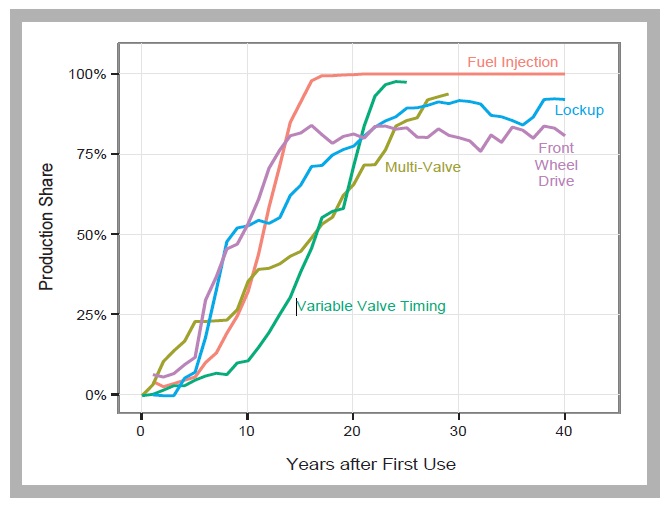Gasoline injection’s rapid growth
Dr. Edward P. Becker | TLT Automotive Tribology June 2016
The challenge for tribologists? Finding the best combinations of materials, designs and coatings for fuels.
GASOLINE DIRECT INJECTION (GDI) APPEARS TO BE HERE TO STAY. This conclusion seems justified by the data included in the latest U.S. EPA Light Vehicle Technology Report. Consider Figure 1 showing adoption rates for new powertrain technologies (
1).
Now consider that GDI first entered the U.S. market in 2007, reaching a 30% share in 2013 and a 38% market share in 2014. This growth rate is similar to the adoption rates for the lock-up torque converter and the use of front-wheel drive also shown in Figure 1. Why the rapid growth?
 Figure 1. Adoption rates for new powertrain technologies.
Figure 1. Adoption rates for new powertrain technologies.
To answer that question, consider the major differences between the standard gasoline and diesel engines. Diesel engines are more fuel efficient than comparably sized gasoline engines for two main reasons. First, diesel engines use significantly higher compression ratios (since the temperature rise due to compression is required to ignite the fuel) while in the conventional gasoline engine, the fuel-air mixture must not ignite until the spark plug fires. Also, the diesel engine does not use a throttle. That is, each engine cylinder is completely filled with air each combustion cycle, as any amount of diesel fuel will ignite upon injection if the temperature is high enough, whereas a gasoline-air mixture will only burn if the ratio of air to fuel is about 15 to 1.
GDI is a method of getting around these limitations. The engine cylinder is filled with air initially, and when the air is almost fully compressed near the end of the compression stroke, gasoline is injected directly into the cylinder. Getting the fuel to burn when there is excess air in the cylinder is accomplished by locating the spark plug downstream of the injection site so the local fuel-air ratio is in the range that will support combustion. The act of igniting the fuel before it has a time to mix with the full contents of the cylinder is called the stratified charge strategy.
What does this mean to the engine tribologist? First of all, since the fuel injector is now working against the pressure in the cylinder (rather than atmospheric pressure) and the time available to inject the fuel into the cylinder is much shorter than in the conventional fuel injection systems, the loads on the fuel injector components are much higher. The injector tip also is located in the combustion chamber, meaning the tip must withstand much higher temperatures than in the conventional systems.
The challenge, therefore, for the tribologist is to find the best combinations of materials, designs and coatings to provide long-term durability, dimensional stability, corrosion resistance and resistance to surface deposits for the widest variety of fuels for spark-ignited engines (including gasoline, alcohols and possibly propane and natural gas), all at a reasonable cost.
REFERENCE
1.
U.S. EPA Report. (October 2014), EPA-420-R-14-023a, Light-Duty Automotive Technology, Carbon Dioxide Emissions, and Fuel Economy Trends: 1975 Through 2014.
 Ed Becker is an STLE Fellow and past president. He is president of Friction & Wear Solutions, LLC in Brighton, Mich., and can be reached through his website at www.frictionandwearsolutions.com
Ed Becker is an STLE Fellow and past president. He is president of Friction & Wear Solutions, LLC in Brighton, Mich., and can be reached through his website at www.frictionandwearsolutions.com.